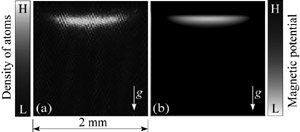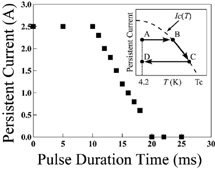1Physical Science Laboratory,
2The University of Electro-Communications/NTT Research Professor
Neutral single atoms are promising candidate for producing quantum
devices. An important technology for developing these quantum devices is
a precise control of the external motion of each single atom. In general,
room temperature (300 K) atoms are moving with relatively high speed at
around 1,000 km/h, but with laser cooling techniques, atoms can be quickly
decelerated to velocities slower than the walking speed of a human being,
i.e., lower than 100 K in temperature. At such a low temperature gravitational
acceleration is significant and atoms start falling down just like a macroscopic
object.
Atoms with non-zero magnetic moment have weak field-seeking states.
They can be trapped with a magnetic potential which competes against the
gravity. The magnetic potential can be easily generated by a current. It
is widely used for trapping large number of atoms. However, trapping single
atoms with a magnetic field generated by a current has never been successful
because of the short lifetime caused by the current noise. This is significant
in a short atom-surface distance which is suitable for making strong confining
single atom traps.
Recently, we have succeeded in developing a persistent supercurrent
atom chip and trapping of atoms in the vicinity of a solid surface with
a practically noise free magnetic field which is highly expected to trap
single atoms. As plotted in Fig.1, 0.5 million rubidium atoms are trapped
about 300 µm away from the atom chip surface, on which a trap is
generated by driving a persistent current of 2.5 Ampere through a MgB2 superconducting loop circuit on a sapphire substrate. Apart from trapping
atoms with a persistent supercurrent, we have also succeeded in controlling
the persistent current with an on-chip thermal switch driven by a laser
(Fig. 2) [1].
In future we will miniaturize the atom chip pattern and try to make
single atom traps with a persistent supercurrent on a solid surface as
a resource for quantum devices.
This research is partially supported by the Japan Science and Technology
Agency CREST "Creation of new technology aiming for the realization
of quantum information processing systems".
[1] T. Mukai, C. Hufnagel, et al., Phys. Rev. Lett. 98 (2007) 260407.
 |
 |
|||||
|
|